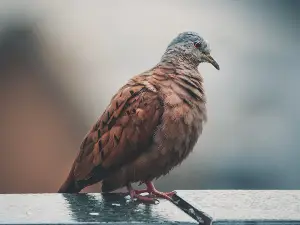
Birds are very active, their feathers take the brunt of them constantly flying. Birds also rub their feathers against trees, preen their feathers, expose them to the suns rays and sometimes get infected with parasites, lice and bacteria. Feathers are fragile, they aren’t made of steel and aren’t impervious to this wear and tear. After a while, they start to look old and worn. This is where moulting kicks in, but when exactly do pigeons moult? This article looks into it.
Pigeons generally moult once a year, this process happens around late summer to early fall. Moulting during the summer months, and not during the winter months, prevent birds from succumbing to the cold. If your bird lives indoors, where sunlight isn’t as regular, this can affect when they moult
Table of Contents
When do pigeons moult?
Moulting is a process whereby birds shed their old and worn feathers to grow a set of new feathers. This is a natural, painless process that needs to be done to maintain the bird’s appearance and the health of the bird overall.
Pigeons moult from around late summer to early fall. Feather loss during this time does not render the bird completely unprotected and exposed to cold temperatures, rather, the warmer temperatures around this time allow the bird to still be comfortable while moulting.
Moulting occurs in a gradual way that does not leave the birds bald and unable to fly. The time it takes for different types of birds to moult differ. Some birds drop their feathers gradually and replace them in a few days while others may not finish moulting until the following year.
How do you tell if a bird is moulting?
Moulting is a natural process in birds and the most obvious sign that a bird is moulting is that it looks ragged and tattered with a lot of feathers on the ground or bottom of its cage. Behavioural signs of a moulting bird include:
- Irritability during moulting, the bird will not let anyone touch them.
- Excessive preening
- The bird will look tired and sleepy.
- Aggressive behavior during moulting. The bird will even bite despite being hand reared.
- Loss of appetite.
- New feathers start to grow on top of the head and tails.
What are the stages of moulting?
Usually, moulting progresses from top to bottom. This is the progression you can expect to see:
- First, the bird starts to shed feathers from its head
- Pin feathers grow in place of the lost feathers.
- As the pin feathers become full feathers, other feathers are shed and the cycle continues until all the feathers are shed and replaced.
Moulting progresses in regular patterns on a bird’s body. Equal amounts of feathers are dropped on each side. This helps the bird regulate its body temperature.
Moulting keeps birds in top flying condition. If a bird is not properly taken care of during moulting this can result in thin, malformed feathers creating difficulties for the bird for a long period of time.
Is moulting painful for birds?
No, moulting is not painful for birds but it is always uncomfortable and stressful for birds. Moulting is similar to shaving, the feathers are already dead so the birds don’t feel pain when they fall out. Also, the feathers aren’t being yanked out by the feather follicle.
The only time a bird might feel pain is during the growth of the pin feathers. Thus, it is important not to try to pet or pick up the bird during this stage. Moulting takes up a lot of energy in birds. The process is often uncomfortable and stressful for these animals
Conclusion
In conclusion, pigeons moult once a year during the late summer to early fall. Moulting at this time allows the bird to keep warm by enjoying the warm temperatures of these months. It also avoids the birds succumbing to the cold in the winter months. If your bird is constantly preening, aggressive, has ragged feathers or there are a lot of feathers at the bottom of its cage then it is likely moulting. This process is not uncomfortable but it can be stressful for birds. After the moulting process, the bird will regrow a new set of beautiful feathers.
If you enjoyed this article then you may also be interested in other bird related articles. Here are some articles that you may be interested in: Why is my bird biting me all of a sudden?, Why is my pigeon shaking?, How do pigeons reproduce?, Where do pigeons roost and why?

